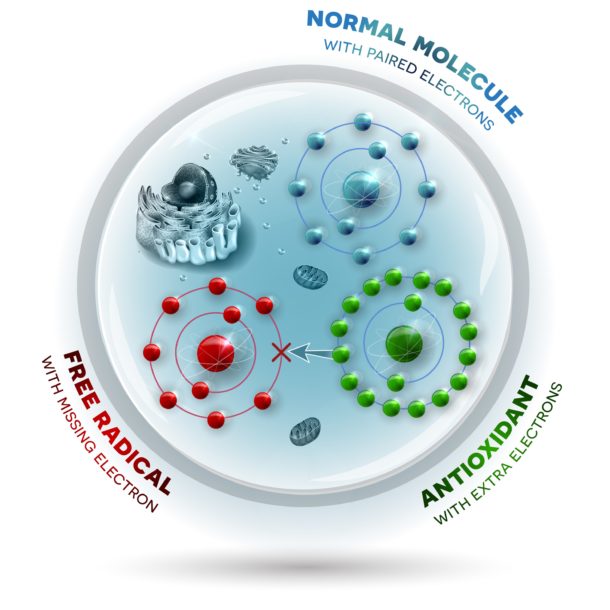Some buzz words you may hear in the health world include “free radicals” and “antioxidants”. Have you ever wondered what they are and what they do? Free radicals are atoms, ions, or molecules with a valence electron (an unpaired electron in the outer shell). This unpaired electron makes them highly unstable and reactive.
How Free Radicals Are Formed:
Free radicals are naturally formed in the body as byproducts of processes such as metabolism and cellular respiration. For example, when your body utilizes oxygen, it creates free radicals as a by product; the damage that these free radicals cause is called oxidative stress. They are also produced because of stress, illness, inflammation, pollution, poor diet, toxic metals, smoking, radiation, medications, and much more. Since metabolism and cellular respiration are continuous, free radicals are constantly being formed. However, completely getting rid of free radicals is neither possible nor coveted. Our immune system actually uses free radicals as defense against bacteria and viruses.
So when exactly do the free radicals become harmful?
When highly reactive free radicals start attacking our cell membranes, DNA, fats, proteins, lipids, and much more, chain reactions* can occur. These “attacks” and chain reactions can result in chronic illnesses such as cancer, Alzheimer’s, autoimmune disorders, ageing, arthritis and cataracts.
*Check out this video for more information about Free Radicals:
Free Radicals and Antioxidants:
Antioxidants are molecules that stabilize highly reactive free radicals. They stop free radicals from causing damage by donating electrons to or accepting electrons from free radicals. This process results in the free radicals having no valence electrons, which stabilizes them. Beneficially, this process does not make antioxidants unstable. Antioxidants are natural substances that exist as vitamins, minerals, and naturally in our body. One example of a naturally formed antioxidant is glutathione, which is capable of preventing damage to cells caused by free radicals.
Above, three molecules are shown in a human cell; the free radical has missing electrons; the antioxidant has extra electrons; there are no missing electrons in the normal molecule (or in a stabilized free radical).
Principle antioxidants:
|
Antioxidant |
What is it? |
What is it found in? |
Other Benefits |
|
Vitamin C |
Most abundant water-soluble vitamin combating free radical formation. It cannot be stored in the body, so remember to take it everyday! |
Red & yellow bell peppers, Kiwis, Broccoli, Strawberries, Cabbage, Citrus fruits such as oranges and lemons |
Supports immune system and increases absorption of iron. |
|
Vitamin E |
Abundant fat-soluble vitamin known for its antioxidant properties. It is a chain breaking antioxidant. |
Sunflower seeds, almonds, Peanuts, Avocado, Spinach and other green vegetables |
Good for face and eyes |
|
Selenium |
Essential mineral; our body cannot produce selenium |
Brazilian nuts, Button & Shiitake mushrooms, Lima beans, Chia seeds, Brown rice |
Maintaining thyroid health |
|
Beta Carotene |
Reddish-orange pigment important in the diet since it is a precursor of Vitamin A |
Carrot, Sweet potato, Kale, Pumpkin/Squash, Dark green leafy vegetables such as spinach, Red peppers |
Is converted into Vitamin A by the body; Vitamin A is essential for healthy skin, mucous membranes, immune system, and good eye health |
|
Curcuminoid |
It is the active ingredient in Turmeric and activates immune system, protects brain, influences gene expression |
Polyphenol turmeric compounds |
It is anti-inflammatory, antioxidant, anticancer, antiseptic, immune system booster |
|
Polyphenol |
Chemicals that naturally occur in plants: phytochemicals |
Dark Chocolate, Curcumin, Oranges, Apples, Spinach, Red wine |
Lowers the risk of type 2 diabetes, boost insulin sensitivity, lowers inflammation, lower amounts of “bad” cholesterol |
|
Anthocyanin |
Purple, red, and blue colored pigment |
Berries, Eggplant, Red cabbage, Red grapes |
Enhances heart health, protects against obesity, aid in prevention of breast cancer |
|
Lycopene |
Bright red pigments; carotenoid |
Tomatoes, Watermelon, Papayas |
Lowers risk of prostate cancer, Lowers risk if blood clots, Lowers risk of developing strokes |
Free radicals are naturally formed in the body as by products of reactions such as metabolism, cellular respiration, stress, illness, and inflammation. Free radicals can be neutralized by antioxidants. For example, Vitamin C stops the formation of free radicals and Vitamin E breaks the already formed chains. Fortunately, this process does not make antioxidants harmful. The above chart indicates that maintaining a balanced and colorful diet ensures your intake of antioxidants. Remember to take Vitamin C everyday and to increase your dosage when you are sick or traveling (since it is an immunity booster). Good ways to obtain your Vitamin C is with sambucus lozenges, Emergen-C drink mix, or any other Vitamin C supplement. The Vitamin C will also help your body with iron absorption, so there is an added benefit for you.



Leave a reply